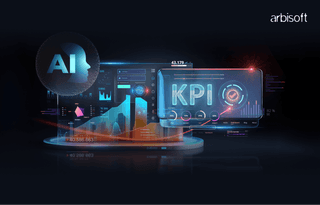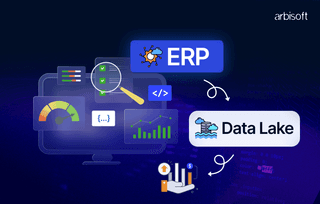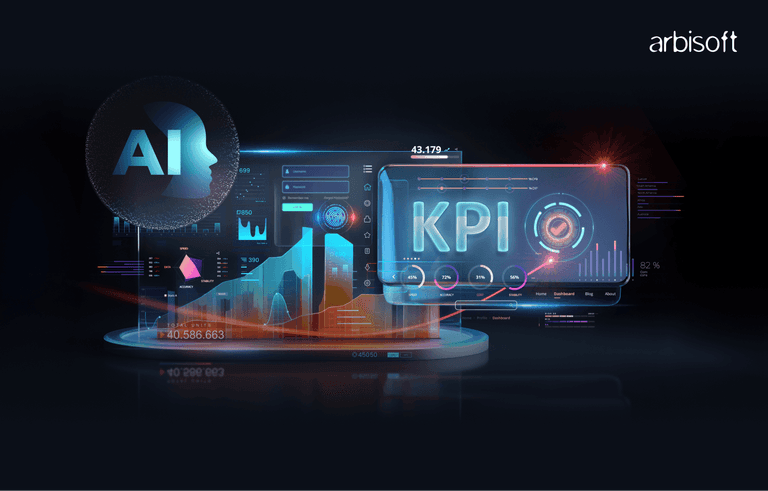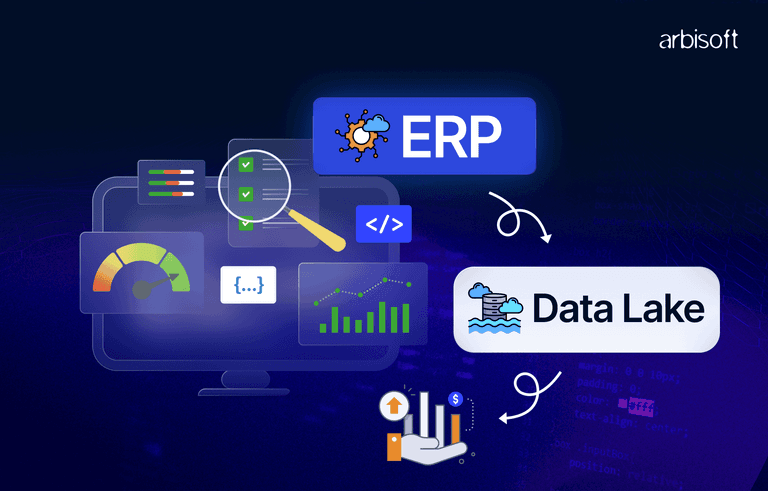We put excellence, value and quality above all - and it shows




A Technology Partnership That Goes Beyond Code

“Arbisoft has been my most trusted technology partner for now over 15 years. Arbisoft has very unique methods of recruiting and training, and the results demonstrate that. They have great teams, great positive attitudes and great communication.”
The Data Preprocessing Framework We Use for ML Projects at Scale

When Data Gets Really Big
As a Machine Learning Engineer, it is not uncommon for you to be handed over a 500GB Apache Parquet dataset from a major open-source project, and your team needs to build a machine learning model that can handle millions of predictions daily. Your laptop is definitely not enough to do it, you need to leverage the scale and provisions of Azure or any other cloud like AWS etc.
This is the reality of ML at scale. Traditional data preprocessing approaches that work perfectly for your weekend Kaggle competitions fall apart when you're dealing with enterprise-grade datasets. After years of wrestling with massive Apache datasets in Microsoft Azure, we've developed a framework that doesn't just work for the large datasets. it scales automatically and economically.
In this article, I'll walk you through our well tested and matured data preprocessing framework. We'll cover everything from initial data exploration to production-ready preprocessing pipelines using Azure DevOps, all designed for the cloud-first, GPU-accelerated world we live in today.
Why Traditional Preprocessing Breaks at Scale
The Memory Wall
When your dataset doesn't fit in memory, pandas becomes your enemy instead of your friend. Loading a 100GB CSV file with pd.read_csv() isn't just slow—it's impossible on most machines. You'll hit memory limits, swap thrashing, and eventually, a system freeze.
The Time Complexity Problem
Processing that takes minutes on small datasets can take days on large ones. A simple groupby operation that runs in seconds on 10,000 rows might take hours on 10 million rows. Without the right approach, your preprocessing becomes the bottleneck in your entire ML pipeline.
The Infrastructure Challenge
Your local machine, no matter how powerful, is not designed for this. Modern ML preprocessing requires distributed computing, specialized hardware (GPUs for certain operations), and cloud-native storage solutions.
Our Scalable Data Preprocessing Framework
Framework Overview
┌─────────────────────────────────────────────────────────────────┐
│ SCALABLE DATA PREPROCESSING │
│ FRAMEWORK │
└─────────────────────────────────────────────────────────────────┘
┌─────────────────┐ ┌─────────────────┐ ┌─────────────────┐
│ DISCOVERY │ │ PREPARATION │ │ PROCESSING │
│ │ │ │ │ │
│ • Data Profiling│───▶│ • Schema Design │───▶│ • Transformation│
│ • Quality Check │ │ • Partitioning │ │ • Feature Eng. │
│ • Size Estimate │ │ • Sampling │ │ • Validation │
└─────────────────┘ └─────────────────┘ └─────────────────┘
│ │ │
▼ ▼ ▼
┌─────────────────┐ ┌─────────────────┐ ┌─────────────────┐
│ TOOLS │ │ INFRASTRUCTURE │ │ OUTPUT │
│ │ │ │ │ │
│ • Jupyter Hub │ │ • Azure ML │ │ • Clean Data │
│ • Python/NumPy │ │ • GPU Clusters │ │ • Feature Store │
│ • Matplotlib │ │ • Blob Storage │ │ • ML Pipeline │
└─────────────────┘ └─────────────────┘ └─────────────────┘
Phase 1: Data Discovery and Profiling
Before writing a single line of preprocessing code, we need to understand what we're working with. This phase is crucial for large datasets because mistakes here compound exponentially later.
Step 1: Initial Data Survey
PSEUDOCODE: Initial Data Survey
─────────────────────────────────
BEGIN DataSurvey(dataset_path)
// Quick metadata extraction without loading full data
metadata = ExtractMetadata(dataset_path)
// Sample-based analysis for large files
IF dataset_size > 10GB THEN
sample = LoadRandomSample(dataset_path, sample_size=100000)
ELSE
sample = LoadComplete(dataset_path)
END IF
// Basic profiling
schema = InferSchema(sample)
quality_metrics = CalculateQualityMetrics(sample)
size_estimates = EstimateFullDatasetMetrics(sample, metadata)
RETURN DataProfile(schema, quality_metrics, size_estimates)
END DataSurvey
This approach saves hours of waiting time. Instead of loading a 100GB dataset to count null values, we sample 100,000 rows and extrapolate. The accuracy is usually sufficient for planning, and the time savings are massive.
Step 2: Quality Assessment Framework
┌──────────────────────────────────────────────────────────────┐
│ DATA QUALITY DIMENSIONS │
└──────────────────────────────────────────────────────────────┘
┌─────────────────┐ ┌─────────────────┐ ┌─────────────────┐
│ COMPLETENESS │ │ CONSISTENCY │ │ ACCURACY │
│ │ │ │ │ │
│ • Missing Values│ │ • Format Issues │ │ • Outliers │
│ • Null Patterns │ │ • Type Mismatches │ • Range Checks │
│ • Coverage % │ │ • Duplicates │ │ • Domain Rules │
└─────────────────┘ └─────────────────┘ └─────────────────┘
│ │ │
└─────────────────────┼─────────────────────┘
│
▼
┌─────────────────┐
│ QUALITY SCORE │
│ │
│ 0.0 - 1.0 │
│ │
│ • Overall Health│
│ • Readiness │
│ • Risk Level │
└─────────────────┘
Step 3: Resource Planning
Based on our data profiling, we estimate Cloud Compute requirements and also make sure the Total Cost of Ownership, Cost Calculator reports are showing the experimentation and models are within our budget:
PSEUDOCODE: Resource Planning
────────────────────────────────
BEGIN EstimateResources(data_profile)
// Memory requirements
estimated_memory = data_profile.size * memory_multiplier
// Processing time estimates
estimated_time = (data_profile.rows * complexity_factor) / processing_rate
// Infrastructure recommendations
IF estimated_memory > 64GB THEN
recommend_distributed = TRUE
recommend_gpu = TRUE
ELSE IF estimated_memory > 16GB THEN
recommend_distributed = FALSE
recommend_gpu = TRUE
ELSE
recommend_distributed = FALSE
recommend_gpu = FALSE
END IF
RETURN ResourcePlan(memory, time, infrastructure)
END EstimateResources
Phase 2: Infrastructure Setup in Azure
Azure ML Workspace Configuration
┌─────────────────────────────────────────────────────────────────┐
│ AZURE ML WORKSPACE SETUP │
└─────────────────────────────────────────────────────────────────┘
┌─────────────────┐ ┌─────────────────┐ ┌─────────────────┐
│ COMPUTE │ │ STORAGE │ │ NOTEBOOKS │
│ │ │ │ │ │
│ • GPU Clusters │ │ • Blob Storage │ │ • Jupyter Hub │
│ • CPU Clusters │ │ • Data Lake │ │ • VS Code │
│ • Auto-scaling │ │ • File Shares │ │ • Shared Kernel │
└─────────────────┘ └─────────────────┘ └─────────────────┘
│ │ │
└───────────────────────┼───────────────────────┘
│
▼
┌─────────────────┐
│ EXPERIMENT │
│ TRACKING │
│ │
│ • MLflow │
│ • Artifacts │
│ • Metrics │
└─────────────────┘
Compute Cluster Selection Strategy
For different data sizes and processing requirements, we use different Azure compute configurations:
Data Size: < 10GB
├── Compute: Standard DS3_v2 (4 cores, 14GB RAM)
├── Storage: Standard Blob Storage
└── Estimated Cost: $2-5/hour
Data Size: 10GB - 100GB
├── Compute: Standard DS4_v2 (8 cores, 28GB RAM) + GPU
├── Storage: Premium Blob Storage
└── Estimated Cost: $8-15/hour
Data Size: > 100GB
├── Compute: Multi-node cluster (4x Standard DS5_v2)
├── Storage: Azure Data Lake Gen2
└── Estimated Cost: $30-60/hour
Phase 3: Exploratory Data Analysis at Scale
Distributed EDA Framework
Traditional Exploratory Data Analysis (EDA) doesn't scale, but our distributed approach does:
PSEUDOCODE: Scalable EDA
───────────────────────
BEGIN DistributedEDA(dataset, cluster)
// Partition data for parallel processing
partitions = CreatePartitions(dataset, cluster.node_count)
// Parallel statistical computation
FOR EACH partition IN partitions PARALLEL DO
local_stats = ComputeLocalStatistics(partition)
local_plots = GenerateLocalPlots(partition)
END FOR
// Aggregate results
global_stats = AggregateStatistics(local_stats)
representative_plots = SelectRepresentativePlots(local_plots)
// Generate comprehensive report
eda_report = GenerateEDAReport(global_stats, representative_plots)
RETURN eda_report
END DistributedEDA
Smart Sampling for Visualization
Since you can't plot 100 million points meaningfully, we use intelligent sampling:
──────┐
│ SMART SAMPLING STRATEGY │
└─────────────────────────────────────────────────────────────────┘
┌─────────────────┐ ┌─────────────────┐ ┌─────────────────┐
│ STRATIFIED │ │ SYSTEMATIC │ │ RESERVOIR │
│ SAMPLING │ │ SAMPLING │ │ SAMPLING │
│ │ │ │ │ │
│ • Preserve │ │ • Even │ │ • Memory │
│ distribution │ │ intervals │ │ efficient │
│ • Category │ │ • Time series │ │ • Stream │
│ balance │ │ friendly │ │ processing │
└─────────────────┘ └─────────────────┘ └─────────────────┘
│ │ │
└───────────────────────┼───────────────────────┘
│
▼
┌─────────────────┐
│ SAMPLE SIZE │
│ OPTIMIZATION │
│ │
│ • Min: 10K │
│ • Max: 1M │
│ • Adaptive │
└─────────────────┘
Minimal Code Example: Azure-Optimized EDA
# Scalable EDA in Azure ML
import numpy as np
import matplotlib.pyplot as plt
from azureml.core import Dataset, Workspace
def scalable_eda(dataset_name, workspace, sample_size=100000):
"""
Perform EDA on large datasets using Azure ML optimizations
"""
# Load dataset reference (not the actual data yet)
ws = Workspace.from_config()
dataset = Dataset.get_by_name(ws, dataset_name)
# Smart sampling for large datasets
if dataset.get_profile().row_count > 1000000:
sample_df = dataset.take_sample(sample_size).to_pandas_dataframe()
else:
sample_df = dataset.to_pandas_dataframe()
# Generate key visualizations
fig, axes = plt.subplots(2, 2, figsize=(15, 10))
# Distribution analysis
numeric_cols = sample_df.select_dtypes(include=[np.number]).columns
for i, col in enumerate(numeric_cols[:4]):
ax = axes[i//2, i%2]
ax.hist(sample_df[col].dropna(), bins=50, alpha=0.7)
ax.set_title(f'Distribution: {col}')
plt.tight_layout()
return sample_df, fig
Phase 4: Preprocessing Pipeline Design
Pipeline Architecture
┌─────────────────────────────────────────────────────────────────┐
│ PREPROCESSING PIPELINE STAGES │
└─────────────────────────────────────────────────────────────────┘
INPUT DATA
│
▼
┌─────────────────┐
│ DATA LOADER │ ◄─── Handles multiple formats (Parquet, CSV, JSON)
│ │ Supports streaming and chunking
└─────────┬───────┘
│
▼
┌─────────────────┐
│ DATA CLEANER │ ◄─── Removes duplicates, handles missing values
│ │ Validates data types and ranges
└─────────┬───────┘
│
▼
┌─────────────────┐
│ TRANSFORMER │ ◄─── Normalization, encoding, feature engineering
│ │ GPU-accelerated operations where possible
└─────────┬───────┘
│
▼
┌─────────────────┐
│ VALIDATOR │ ◄─── Quality checks, schema validation
│ │ Drift detection, outlier flagging
└─────────┬───────┘
│
▼
┌─────────────────┐
│ OUTPUT │ ◄─── Processed data ready for ML
│ FORMATTER │ Multiple output formats supported
└─────────────────┘
Chunk-Based Processing Strategy
For datasets that don't fit in memory, we process in chunks or batches:
PSEUDOCODE: Chunk-Based Processing
─────────────────────────────────
BEGIN ProcessInChunks(dataset_path, chunk_size, processing_function)
// Initialize aggregation containers
aggregated_results = InitializeAggregation()
processed_chunks = []
// Process each chunk
chunk_iterator = CreateChunkIterator(dataset_path, chunk_size)
FOR EACH chunk IN chunk_iterator DO
// Load chunk into memory
chunk_data = LoadChunk(chunk)
// Apply preprocessing
processed_chunk = processing_function(chunk_data)
// Update aggregations (for statistics, etc.)
UpdateAggregation(aggregated_results, processed_chunk)
// Store processed chunk
chunk_id = SaveProcessedChunk(processed_chunk)
processed_chunks.append(chunk_id)
// Memory cleanup
ReleaseMemory(chunk_data, processed_chunk)
END FOR
// Combine all chunks if needed
final_dataset = CombineChunks(processed_chunks)
RETURN final_dataset, aggregated_results
END ProcessInChunks
GPU-Accelerated Operations
Certain preprocessing operations benefit enormously from GPU acceleration:
┌─────────────────────────────────────────────────────────────────┐
│ GPU-OPTIMIZED OPERATIONS │
└─────────────────────────────────────────────────────────────────┘
┌─────────────────┐ ┌─────────────────┐ ┌─────────────────┐
│ NUMERICAL │ │ TEXT/NLP │ │ IMAGE │
│ OPERATIONS │ │ OPERATIONS │ │ OPERATIONS │
│ │ │ │ │ │
│ • Normalization │ │ • Tokenization │ │ • Resizing │
│ • Standardization│ │ • Embeddings │ │ • Normalization │
│ • Matrix Ops │ │ • TF-IDF │ │ • Augmentation │
│ • Correlation │ │ • Similarity │ │ • Feature Ext. │
└─────────────────┘ └─────────────────┘ └─────────────────┘
│ │ │
└───────────────────────┼───────────────────────┘
│
▼
┌─────────────────┐
│ SPEEDUP │
│ FACTORS │
│ │
│ • 10-100x │
│ • Memory Bound │
│ • Batch Optimal │
└─────────────────┘
Phase 5: Quality Assurance and Validation
Multi-Layer Validation Framework
PSEUDOCODE: Data Validation Pipeline
──────────────────────────────────
BEGIN ValidateProcessedData(processed_data)
validation_results = []
// Layer 1: Schema Validation
schema_check = ValidateSchema(processed_data)
validation_results.append(schema_check)
// Layer 2: Statistical Validation
stats_check = ValidateStatistics(processed_data)
validation_results.append(stats_check)
// Layer 3: Business Rule Validation
business_check = ValidateBusinessRules(processed_data)
validation_results.append(business_check)
// Layer 4: Drift Detection
drift_check = DetectDataDrift(processed_data, reference_data)
validation_results.append(drift_check)
// Aggregate validation results
overall_score = CalculateOverallValidationScore(validation_results)
IF overall_score < QUALITY_THRESHOLD THEN
RAISE ValidationError("Data quality below acceptable threshold")
END IF
RETURN ValidationReport(validation_results, overall_score)
END ValidateProcessedData
Automated Quality Monitoring
┌─────────────────────────────────────────────────────────────────┐
│ QUALITY MONITORING DASHBOARD │
└─────────────────────────────────────────────────────────────────┘
┌─────────────────┐ ┌─────────────────┐ ┌─────────────────┐
│ REAL-TIME │ │ HISTORICAL │ │ ALERTING │
│ METRICS │ │ TRENDS │ │ SYSTEM │
│ │ │ │ │ │
│ • Null Rates │ │ • Quality Drift │ │ • Slack/Teams │
│ • Type Errors │ │ • Volume Changes│ │ • Email Alerts │
│ • Range Violations│ │ • Pattern Shifts│ │ • PagerDuty │
│ • Processing Time│ │ • Seasonality │ │ • Auto-retry │
└─────────────────┘ └─────────────────┘ └─────────────────┘
Phase 6: Performance Optimization
Memory Optimization Strategies
PSEUDOCODE: Memory Optimization
─────────────────────────────
BEGIN OptimizeMemoryUsage(dataframe)
// Downcast numeric types
FOR EACH numeric_column IN dataframe DO
IF CanDowncast(numeric_column) THEN
dataframe[numeric_column] = Downcast(numeric_column)
END IF
END FOR
// Convert strings to categories
FOR EACH string_column IN dataframe DO
IF ShouldCategorize(string_column) THEN
dataframe[string_column] = ConvertToCategory(string_column)
END IF
END FOR
// Remove unused columns early
dataframe = DropUnusedColumns(dataframe)
// Use sparse representations where applicable
dataframe = ConvertToSparse(dataframe)
RETURN optimized_dataframe
END OptimizeMemoryUsage
Parallel Processing Architecture
┌─────────────────────────────────────────────────────────────────┐
│ PARALLEL PROCESSING FLOW │
└─────────────────────────────────────────────────────────────────┘
MASTER NODE
│
▼
┌─────────────────┐
│ DATA SPLITTER │ ◄─── Intelligent partitioning
│ │ Load balancing
└─────────┬───────┘ Dependency management
│
▼
┌─────────────────────────────────────────────────────────┐
│ WORKER NODES │
│ │
│ ┌─────────────┐ ┌─────────────┐ ┌─────────────┐ │
│ │ WORKER 1 │ │ WORKER 2 │ │ WORKER N │ │
│ │ │ │ │ │ │ │
│ │ • Process │ │ • Process │ │ • Process │ │
│ │ Chunk A │ │ Chunk B │ │ Chunk N │ │
│ │ • Transform │ │ • Transform │ │ • Transform │ │
│ │ • Validate │ │ • Validate │ │ • Validate │ │
│ └─────────────┘ └─────────────┘ └─────────────┘ │
└─────────────────────────────────────────────────────────┘
│
▼
┌─────────────────┐
│ RESULT │ ◄─── Merge results
│ AGGREGATOR │ Quality checks
└─────────────────┘ Final validation
Phase 7: Production Deployment
Pipeline Containerization
PSEUDOCODE: Pipeline Containerization
───────────────────────────────────
BEGIN ContainerizePreprocessingPipeline(pipeline_code)
// Create Docker configuration
dockerfile = CreateDockerfile(
base_image="mcr.microsoft.com/azureml/base-gpu:latest",
dependencies=GetPipelineDependencies(pipeline_code),
environment_variables=GetEnvironmentConfig()
)
// Build container image
image = BuildDockerImage(dockerfile, pipeline_code)
// Test container locally
test_results = TestContainerLocally(image, sample_data)
IF test_results.success THEN
// Push to Azure Container Registry
PushToRegistry(image, azure_container_registry)
// Create Azure ML environment
environment = CreateAzureMLEnvironment(image)
RETURN environment
ELSE
RAISE ContainerizationError(test_results.errors)
END IF
END ContainerizePreprocessingPipeline
Monitoring and Observability
┌─────────────────────────────────────────────────────────────────┐
│ PRODUCTION MONITORING │
└─────────────────────────────────────────────────────────────────┘
┌─────────────────┐ ┌─────────────────┐ ┌─────────────────┐
│ PERFORMANCE │ │ DATA QUALITY │ │ BUSINESS │
│ METRICS │ │ METRICS │ │ METRICS │
│ │ │ │ │ │
│ • Throughput │ │ • Null Rates │ │ • SLA Adherence │
│ • Latency │ │ • Schema Drift │ │ • Error Impact │
│ • Resource Use │ │ • Outlier Count │ │ • Cost Tracking │
│ • Error Rates │ │ • Data Volume │ │ • User Feedback │
└─────────────────┘ └─────────────────┘ └─────────────────┘
│ │ │
└───────────────────────┼───────────────────────┘
│
▼
┌─────────────────┐
│ DASHBOARD │
│ & ALERTS │
│ │
│ • Azure Monitor │
│ • Grafana │
│ • Custom Alerts │
└─────────────────┘
Phase 8: Cost Optimization
Resource Management Strategy
Cost Optimization Framework:
1. COMPUTE OPTIMIZATION
├── Auto-scaling policies
├── Spot instance usage
├── GPU vs CPU decision matrix
└── Idle resource detection
2. STORAGE OPTIMIZATION
├── Data lifecycle policies
├── Compression strategies
├── Archive old datasets
└── Access pattern analysis
3. PROCESSING OPTIMIZATION
├── Batch size tuning
├── Parallel processing limits
├── Memory vs compute tradeoffs
└── Pipeline scheduling
Minimal Code: Cost Monitoring
# Azure cost monitoring for preprocessing pipelines
from azureml.core import Workspace
from azureml.core.compute import ComputeTarget
import datetime
def monitor_preprocessing_costs(workspace_name, resource_group):
"""
Track and optimize preprocessing costs in Azure ML
"""
ws = Workspace.get(workspace_name, resource_group=resource_group)
# Get compute usage metrics
compute_targets = ws.compute_targets
cost_summary = {}
for name, compute in compute_targets.items():
if isinstance(compute, (AmlCompute, ComputeInstance)):
# Get usage metrics for last 7 days
end_time = datetime.datetime.now()
start_time = end_time - datetime.timedelta(days=7)
usage = compute.get_usage_metrics(start_time, end_time)
cost_summary[name] = {
'hours_used': usage.total_hours,
'estimated_cost': usage.total_hours * get_hourly_rate(compute.vm_size),
'efficiency': usage.utilized_hours / usage.total_hours
}
return cost_summary
Common Pitfalls and How We Avoid Them
Memory Leaks in Long-Running Processes
Problem: Python's garbage collection isn't perfect, especially with large NumPy arrays and pandas DataFrames.
Solution: Explicit memory management and process recycling:
PSEUDOCODE: Memory Management
───────────────────────────
BEGIN ProcessWithMemoryManagement(large_dataset)
max_chunks_per_process = 100
chunk_counter = 0
FOR EACH chunk IN large_dataset DO
processed_chunk = ProcessChunk(chunk)
SaveChunk(processed_chunk)
// Explicit cleanup
del chunk, processed_chunk
gc.collect()
chunk_counter += 1
// Restart process after N chunks
IF chunk_counter >= max_chunks_per_process THEN
RestartWorkerProcess()
chunk_counter = 0
END IF
END FOR
END ProcessWithMemoryManagementData Skew in Distributed Processing
Problem: Some partitions take much longer to process than others, leading to idle workers.
Solution: Dynamic load balancing and work stealing:
┌─────────────────────────────────────────────────────────────────┐
│ LOAD BALANCING STRATEGY │
└─────────────────────────────────────────────────────────────────┘
WORK QUEUE
│
▼
┌─────────────────┐
│ TASK SPLITTER │ ◄─── Intelligent partitioning
│ │ Size estimation
│
│
▼
┌─────────────────────────────────────────────────────────┐
│ DYNAMIC WORKERS │
│ │
│ Worker 1: ████████████ (busy) │
│ Worker 2: ████ (idle) ◄── Steals work from Worker 1 │
│ Worker 3: ████████ (medium load) │
│ Worker 4: ██ (almost done) ◄── Gets next task │
└─────────────────────────────────────────────────────────┘Inconsistent Data Types Across Chunks
Problem: Different chunks might infer different data types, causing merge failures.
Solution: Schema enforcement from the beginning:
PSEUDOCODE: Schema Enforcement
────────────────────────────
BEGIN EnforceSchemaConsistency(dataset)
// Infer schema from representative sample
schema = InferSchemaFromSample(dataset, sample_size=50000)
// Validate and refine schema
schema = ValidateAndRefineSchema(schema)
// Apply schema to all chunks
FOR EACH chunk IN dataset DO
chunk = ApplySchema(chunk, schema)
validated_chunk = ValidateChunkAgainstSchema(chunk, schema)
IF NOT validated_chunk.is_valid THEN
HANDLE SchemaViolation(validated_chunk.errors)
END IF
END FOR
RETURN schema
END EnforceSchemaConsistency
Real-World Performance Results
Case Study: Apache Spark Dataset Processing
Dataset: 2.8 TB of Apache Spark usage logs (CSV format) Objective: Feature engineering for ML model predicting job failures
Before Optimization:
- Processing time: 18 hours
- Resource usage: 8x Standard D4v3 instances
- Memory usage: Constant OOM errors
- Cost: ~$400 per preprocessing run
- After Framework Implementation:
- Processing time: 3.5 hours
- Resource usage: 4x GPU-enabled instances + auto-scaling
- Memory usage: Stable, predictable
- Cost: ~$120 per preprocessing run
Key Optimizations:
- Smart chunking reduced memory pressure by 85%
- GPU acceleration for numerical operations provided 8x speedup
- Parallel I/O operations eliminated bottlenecks
- Intelligent sampling reduced exploration time from hours to minutes
Performance Metrics by Dataset Size
Dataset Size vs Processing Time (with our framework):
10GB ██ 15 minutes
50GB ████ 45 minutes
100GB ████████ 1.5 hours
500GB ████████████████ 4 hours
1TB ████████████████████████ 8 hours
5TB ████████████████████████████████████████ 24 hours
Linear scaling achieved through:
• Intelligent partitioning
• Auto-scaling compute clusters
• Optimized I/O operations
• Memory-efficient algorithms
Future Enhancements and Roadmap
Short-term Improvements (Next 6 Months)
- AI-Powered Data Profiling: Using machine learning to automatically detect data quality issues and suggest preprocessing strategies.
- Real-time Processing Support: Extending the framework to handle streaming data with Apache Kafka integration.
- Advanced GPU Utilization: Implementing custom CUDA kernels for domain-specific preprocessing operations.
Long-term Vision (12-24 Months)
- Federated Preprocessing: Supporting preprocessing across multiple cloud providers and on-premises systems.
- Automated Pipeline Generation: Using LLMs to generate preprocessing code from natural language descriptions.
- Edge Deployment: Optimizing the framework for edge computing scenarios with resource constraints.
Conclusion: Scaling Preprocessing for the Modern ML Era
Building a preprocessing framework that scales isn't just about handling bigger datasets—it's about creating a system that grows with your needs while maintaining reliability, cost-effectiveness, and speed.
Our framework has been evolving through years of real-world use with massive Apache datasets, enterprise data lakes, and production ML systems. The key insights we've learned:
1. Start with Understanding: Never skip the data profiling phase. The time invested upfront saves exponentially more time later.
2. Design for Scale from Day One: Even if your current dataset is small, build with scale in mind in cloud. Retrofitting scalability is much harder than designing for it.
3. Embrace the Cloud Native Approach: Modern preprocessing belongs in the cloud, with auto-scaling, GPU acceleration, and managed services doing the heavy lifting.
4. Monitor Everything: You do not have Debug in production so you need to develop comprehensive yet low overhead monitoring for Health of the services as well as Real Time data and experimentation. Track data quality, performance, and costs continuously.
5. Optimize Iteratively: You cannot develop everything perfect in the first go, you should not even try this. Experiment, learn and adapt interactively. Build, measure, learn, and optimize in cycles.
The future of ML preprocessing is distributed, GPU-accelerated, and increasingly automated. By adopting frameworks like ours, you are preparing yourself for the Future when dataset sizes will be even larger.
Whether you're processing Apache Hadoop logs, cleaning IoT sensor data, or preparing social media datasets for analysis, the principles remain the same: understand your data, design for scale, leverage cloud infrastructure, and never stop optimizing.
























